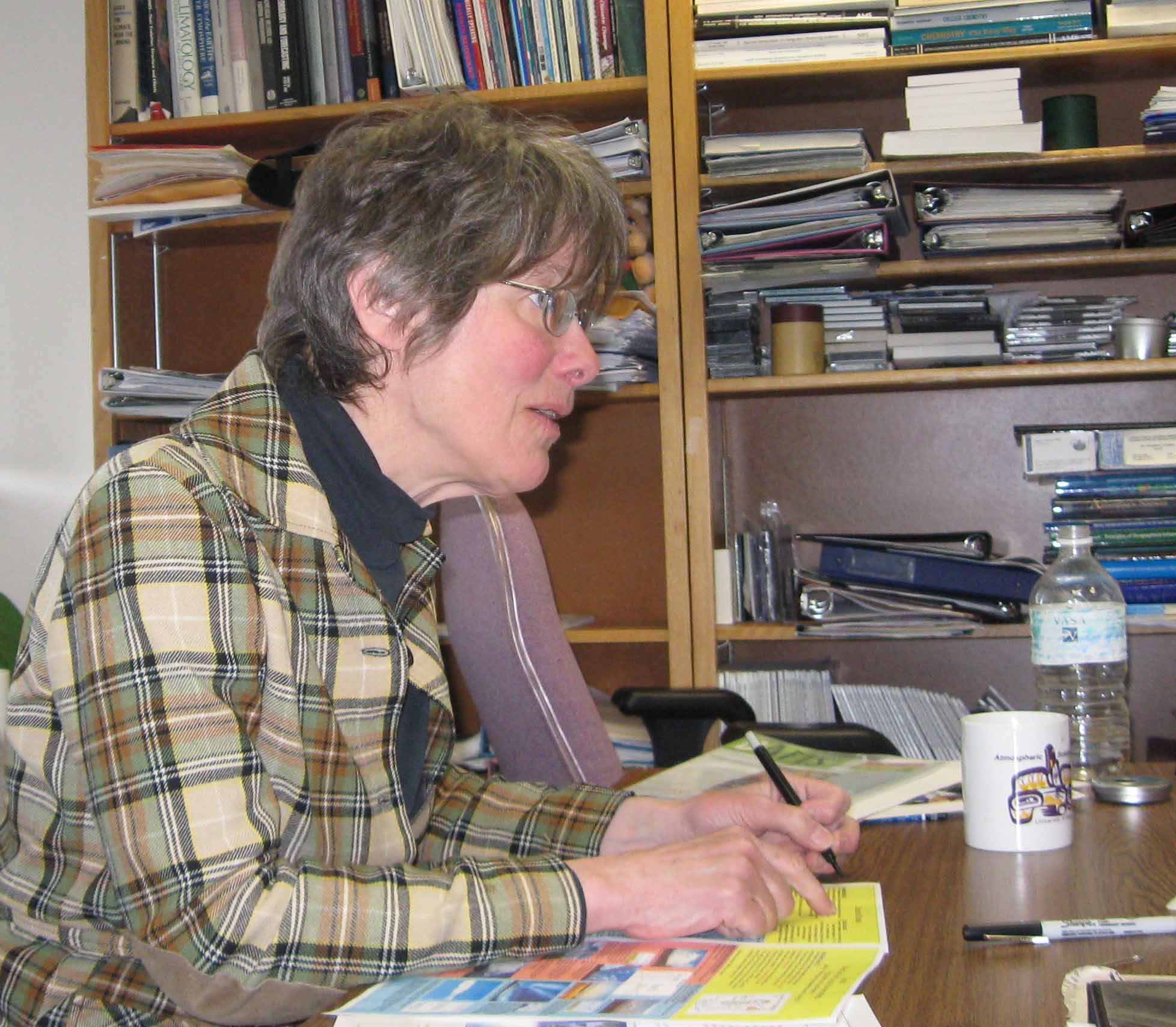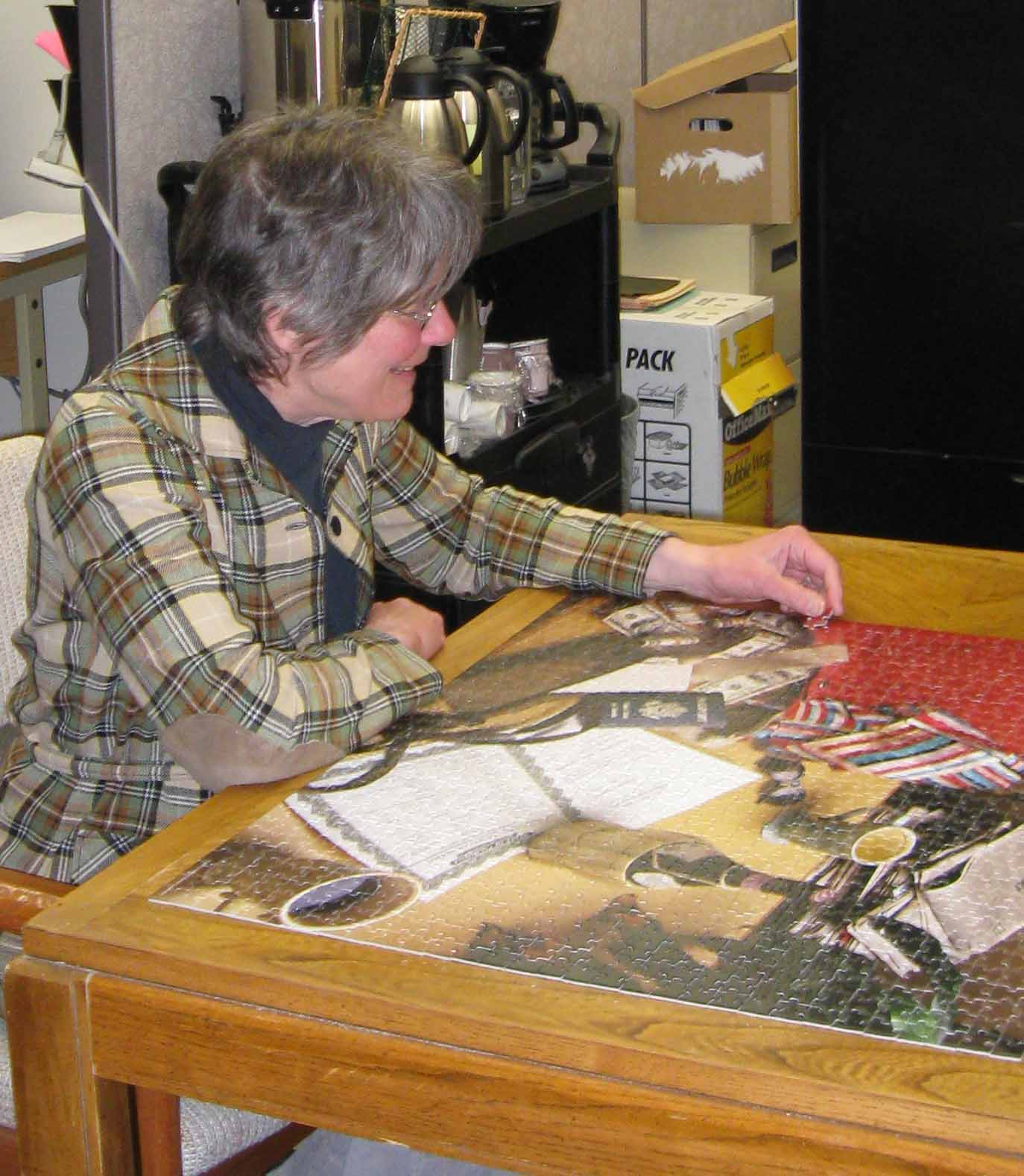Have you ever wondered what it is like to be a scientist? Or the GLOBE Chief Scientist? I do both. My days are sometimes a challenge, since the two jobs are very different. What are these jobs like? Below is described a day that was so richly varied that I thought it would be fun to share it with you.
My husband and I start each day with a 2-mile walk at dawn, during which we observe the animals (deer, foxes, birds), talk, or just walk quietly. I think of many of my blog ideas while on this walk (or on the occasional walks I take on the open space near the office).
After we eat breakfast, we carpool to work. Since we work in two different buildings, he lets me off about 200 meters from where I work and then he drives to his building, which has covered parking. While walking to my building, I take special note of the birds (the other day a hawk and crow flying together) or clouds, sometimes pausing to take a picture. This walk takes me right by the rain gauge that NCAR has as a part of the CoCoRaHS that I have written about before. Sometimes I see someone taking the rainfall measurement.
After arriving at the office, I plug in my laptop (if I took it home overnight) and turn it on. While waiting for it to boot, I turn on my desktop computer and read my email. I was excited to see some comments about a paper that five of us just finished on tropical storm clouds carrying energy from near the surface to 10-14 kilometers and higher. The sender showed me and the other authors a couple of figures that showed the effects of the model resolution (related to the size of motions that the model can deal with directly) on how far air can rise in a cloud model. (A cloud model is designed to predict what the clouds will do). The most exciting thing about this particular paper is that we worked on it almost completely over the Internet. We rarely met in person (though some met at conferences and at the University of Oklahoma). The only person involved that I talked to (over the phone) was the lead author – and that was only once!

Figure 1. At my desk. Here, I’m reviewing a cloud poster that will be presented at a meeting this weekend.
By the time I finished reading the comments on the paper, a colleague (Dr. Fei) came in to tell me about a meeting he had attended the previous day. He told me that the group liked some of the work we had been doing over the past two years on altering the formulas in a model used to represent surface exchanges of heat and moisture in a numerical weather prediction model used for weather forecasting and research. We were going to be asked to present the results to a meeting in April. We talked about what we needed to do for this presentation, and some of the other tasks we were working on together. We will be doing a lot of comparison of the model results to observations. Once we are satisfied that our new version of the model (with the adjusted formulas) is better than the old one, we will change the old one, so that everyone using the model can benefit from what we found out.
After that, it was time for some GLOBE work.
We are working on a way to more easily access scientists when we need them for special events, like Web chats, video conferences, or judging student papers. Another GLOBE staffer (Dr. Sheila) and I had worked on this for a couple of years, getting input from the GLOBE community at the US Globe Annual Meeting in San Antonio, and a meeting for GLOBE and its Science Principal Investigators in Durham, New Hampshire. This morning, I finished writing a document that will be discussed next week. I sent a copy to Dr. Sheila to review before we shared it with others.
I then did some work on the next blog (on birds), looking at the first review that came in, and altering the blog in response to the comments. Each blog has three or four reviewers from the GLOBE staff, and occasionally a scientist outside of GLOBE looks at it if the blog is on a subject that I’m not an expert on; and sometimes even if I am.
Checking email, I discovered I needed to write another letter of recommendation for a young post-doc (someone with a short-term position – usually 1-2 years – right after they get their doctorate) who is looking for a university faculty job. I gathered the needed information, sent the letter as an email, and printed it out for mailing using snail mail, as they requested. I discovered that I needed to write a second letter for the same person, so I did.
By this time, it was time for lunch, so I went downstairs to the NCAR Cafeteria for about a half an hour. We talked about birding on this particular day (maybe because I had questions related to my bird blog). I stopped on the way back to the office to put a piece in a jigsaw puzzle outside the Director’s office. For years, there has been a jigsaw puzzle there for people to work on at odd moments of the day (for me, while waiting for something to come out of the printer, coming back from lunch, or between tasks – just to get up from my desk).

Figure 2. Working on the jigsaw puzzle – this one is basically done.
By the time I got back to my computer, some figures had arrived over the Internet for a paper that we just finished. There are several authors on this paper, because it deals with data that several of us collected in a field campaign in 2002. Each of the authors is reviewing it; and in the meantime, we are refining the figures and fixing minor things we know that are wrong. Dr. Fei is one of the authors. I checked each of the figures, saved them, and inserted them into the manuscript. I compared the captions to the figures, but found that no adjustments were necessary.
Then more emails arrived related to the paper on tropical clouds. This time the lead author had averaged the temperature in the updrafts that had reached 10-14 kilometers in altitude. We exchanged a few messages about whether the averaging time should be shorter than what he was using.
Dr. Sheila had reviewed my document and made several suggestions, which I considered and responded to before emailing it to several GLOBE staffers for a meeting next week.
By this time, it was almost 2:00 p.m., and I needed to post another blog for Dr. C. He sent me an email telling me it was coming, and I sent an email to Karen in GLOBE to stand by for whatever changes she would need to make. The blog arrived at about 1:50 p.m. I checked it for edits, and posted it after altering one figure slightly in Photoshop. There were some concerns about the other figure, however, and I noted that when I let Karen know the blog was posted. I also let Dr. C. know – and checked with him to make sure that he meant millimeters (rather than centimeters) in one part of the blog. He emailed back that he meant millimeters. I discovered the problem with the figure, cropped it, and sent the resulting image to Karen to put in the blog.
After all of this, I headed to a 2:00 p.m. meeting 20 minutes late, and discovered that everyone was coming back. Given this new-found freedom, I put another piece of the puzzle, and organized things for my trip home. When my husband arrived just after 3:00 p.m., several of us talked about the meeting and how NCAR could be saving money.
At 3:15, I went home, and then set up my computer to write a letter of recommendation for a student who is getting his Ph. D. in 2009. I finished at 5:00 p.m.
What have you noticed about this day?
Did you notice how much time I spent writing? And I wasn’t really working on the paper very much. This is not unusual – scientists spend a lot of time writing.
Also – did you notice how much time I spent on the Internet? I am currently working on two papers, and finished one last week. In all cases, the authors are scattered across the country. We hope that more GLOBE students will work together in this way.
Finally, I use math frequently – even simple stuff like averaging. Analyzing weather observations involves math. The models involve a lot of math, including a formula we were working on changing. Finally, analyzing the model output involves math.
Of course physics (and for me a little biology and chemistry) is important as well. The math and writing and Internet are all tools that help with science.
Some days are of course, different. For example, to collect data in field campaigns, we have to go where the weather is. Over my career, I’ve lived in several places – Dakar, Senegal; Taipei, Taiwan; Honiara, Solomon Islands; Guadalajara, Mexico; Mayaguez, Puerto Rico; and several places in the continental United States, while collecting data. Typically, we fly aircraft through the weather we are studying, along tracks we figured out far in advance – so that we can gather the data we need; gather data using radars (including Doppler radars), and use surface towers to make measurements near the earth’s surface.
This blog was inspired by a question at a recent video conference I had with teachers in Iowa.
Postscript: The paper was just accepted for publication.

That is a very interesting day. As I read the article I was very surprised that there was actually time to do a puzzle. You have to take your mind off of things in order to keep sane. Great Job.